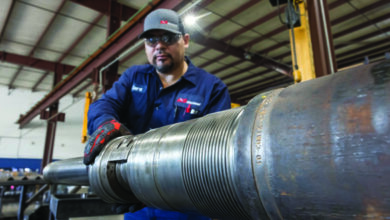Transocean keeps focus on business strategy, customer alignment as it embraces ‘creative destruction’ through digital transformation
Contractor leverages Big Data, Industrial Internet of Things to identify, deliver new value, breakthrough innovations in offshore drilling
By Jose Gutierrez, Transocean Technology and Innovation

Sometimes innovation emerges from new technologies that enable a novel product offering or expansion of an existing product line. However, the most successful innovation takes root in new thinking, a new twist, a new angle or a paradigm shift that is aligned with business strategy to deliver value. As businesses and industries digitally transform, the driving force should be business strategy, with technology playing the fundamental role in the innovation process.
Creative destruction is a term coined by Austrian economist Joseph Schumpeter during his seminal work on the theory of economic innovation and the business cycle. In his research, Dr Schumpeter described creative destruction as the process of transformation of industries that revolutionizes the economic structure from within, destroying the old one and incessantly creating a new one.
Digital transformation uses digital technologies to solve business challenges. For offshore drilling, digitalization is enabled by the Industrial Internet of Things (IIoT) – the use of internet technology to enable machine-to-machine communications – and Big Data – huge amounts of data collected from a variety of sensors and equipment from which process performance or machine health can be measured. This capability comes in handy at a time when business cycle pressures are pushing cost reductions and differentiated service delivery.
Roadmap to Breakthroughs in Offshore Drilling
Studies have shown that offshore drilling is not yet achieving maximum efficiency levels, so in the context of digital transformation, many opportunities exist for breakthrough innovation that improves our cost and operating efficiency. The opportunities range from anticipating the remaining useful life of critical equipment to optimizing discrete events in key processes that deliver improved performance. These elements could enable breakthroughs in the offshore drilling industry that provide quantifiable safety levels (the ability to measure safety integrity of critical operational equipment) and continuous improvement of machinery processes (the continuous measurement and optimization of critical processes that affect the efficiency of key operational systems and subsystems).
The journey at Transocean started with defining its IIoT and Big Data roadmap in the fall of 2016. By the end of Q1 2017, the company had fully IIoT-enabled its first rig. In less than six months, physics-based models, augmented by machine-learning algorithms, were applied to key critical equipment. This has allowed the company to anticipate certain potential failures earlier than it otherwise may have and to increase the consistency of drilling performance by more than 30% for some rigs – a major breakthrough, but just the beginning.
IIOT in Offshore Drilling
IIoT has existed with different names for 30 years. At first, its implementation took the shape of bulky, complex, proprietary and very expensive Supervisory Control and Data Acquisition (SCADA) systems. Today, computing power, memory and the ability to perform complex analytics are accessible at very low costs. Additionally, a new generation of skilled mathematicians and statisticians are attracted to this field because of the availability of data generated by machines and their associated processes.
IIoT has democratized some industries by lowering the barrier to entry for many companies through the standardization of digitally enabled solutions in a highly regulated, safety-sensitive and capital-intensive world. For instance, IIoT now enables the use of off-the-shelf and inexpensive sensors to weave together information around a product, plant or service. This information, in turn, is processed to observe and correct inefficiencies, design new processes, interact with customers and empower workforces. Pre-packaged algorithms and data visualization packages are quickly placed into the hands of a multitude of users who can now act on real-time information to drive improvement across an organization.
Within Transocean, a targeted push has been made to develop performance dashboards with custom visualization graphics, designed by cognitive psychologists, that are used daily by rig managers, toolpushers and drillers to analyze, review and improve drilling service KPIs. These contribute to overall well construction efficiency and highlight sources of nonproductive time. Customers are also able to view these same graphics for the Transocean rigs they have on contract. The result of these efforts has been a meaningful improvement in drilling service KPIs across the fleet and greater alignment with customers in terms of delivering their well plans according to schedule.
As proficiency at measuring and driving performance improves, nonproductive time will decrease and operational efficiency will improve. Ultimately, this could lead to additional performance-based incentives with customers or suppliers targeted toward areas in which performance can be improved. The more data measurements and efficiency improvement processes can be used to align incentives across the offshore value chain, the more competitive offshore becomes in the global energy mix.

In addition, a major challenge of any IIoT proof of concept is data quality. Studies have shown the task of data cleansing or removing data artifacts, such as noise, interference, gaps, etc, can take 80% of the time of any IIoT deployment regardless of industry. Transocean has found this to be true in many digitization efforts. Moreover, the variety of IIoT analytical platforms and solutions can lead to confusion about what solution or platform will most effectively solve the problem. Model-based? Artificial intelligence? Statistical methods? Even more interesting offerings can further challenge this journey. Have you heard the pitch: “Give me your data and I will solve all your problems?” This is only possible once the data is processed and the proper problem-solving approach is selected.
At Transocean, a data-driven strategy has been created that encompasses the entire organization. HR, procurement, operations, HSE and other departments are leveraging digital technologies to improve key performance metrics. Further, human-centered design engineering is being married with digital efforts, which makes it easier for teams to take appropriate action when presented with the results of digitization efforts. When done correctly, the benefits of Big Data and IIoT are placed in the hands of many employees, which encourages all to become contributors to Transocean’s data-driven transformation.
Delivering Material Value
While the described challenges remain in accomplishing a digital transformation, let’s go back to the beginning – a discussion of innovation. What is needed to drive digital transformation? How can the opportunity be captured?
The key requirement for digital transformation is an organizational commitment to delivering an existing or a new business strategy (the “what”) using highly available IIoT infrastructure (the “how”). Most organizations already have significant amounts of available data, but this data sits in silos, unstructured and ineffectively analyzed. The effort to digitize is about unleashing value from your business ecosystem, enabled by using highly available IIoT technology – before your competitor does. As such, success is achieved through the committed execution of your own thoughtful business strategy, with IIoT as the enabler. This is the journey of creative destruction, or as defined in the 21st century: “Digital Transformation.” DC
This article is based on a presentation at IADC World Drilling 2018, 19-20 June, Copenhagen, Denmark.




